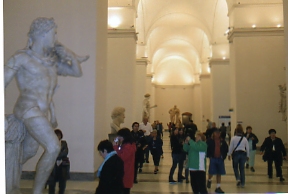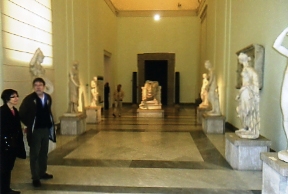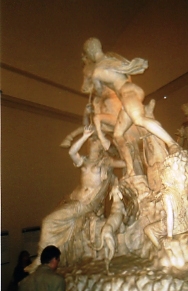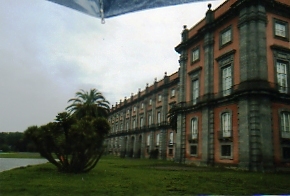

Southern Italy’s Artistic Legacy
By Tom Frascella March, 2011
Southern Italy owes a debt of thanks for the cultural preservation and expansion of its artistic traditions to the 18th century Bourbon Dynasty. Beginning with Charles the VIII ascension to the thrown of the United Kingdoms of Naples and Sicily in 1734 southern Italy enjoyed a new found patronage of art and architecture. Charles very aggressively improved infrastructure, built up the navy, encouraged the Arts and commissioned many elaborate palaces and buildings. Charles would remain regent from 1734-1750.
His mother Elizabeth was heir to the Farnese family fortune and the Duchy of Parma. Although, she would eventually abdicate that inheritance in favor of her son, it was Elizabeth birthright which brought the extensive Farnese Art collection to Naples from Parma. The Farnese family had been major players in the political and social hierarchy of Italy for generations producing successful merchants, politicians, religious leaders and Popes in remarkable numbers. In turn these very successful individuals had amassed many valuable and unique treasures. Charles would inherit from his mother not only Art but an appreciation for collecting Art.
During Charles’ reign many great Palaces were built and items from the Farnese Collection served to decorate and inspire the living spaces of many of them. It was also during the reign of Charles that the ancient ruins of the long lost and deeply buried city of Pompeii were rediscovered under some forty feet of volcanic ash. Charles sponsored and encouraged the early excavations at Pompeii which uncovered many priceless objects including ancient art work hidden from view for almost two thousand years. These ancient artistic treasures were added to the extensive art collection of the Farnese and displayed in the Bourbon Palaces of Naples.
In 1750 Charles VIII abdicated the crown of Southern Italy in favor of his infant son, in order to assume the Crown of Spain as Charles III. However, Charles did not leave Italy before establishing a Museum. Charles recognized the need to house the expanding collection of ancient treasure being unearthed. The museum was established at the seat of the University of Naples, 1616-1777, in a building that had originally been built as a cavalry barracks. The building was located at what had been the northwest wall of the original city limit of the ancient Greek city of Neapolis. Charles although absent from Southern Italy would remain throughout his life extremely interested in the excavations of Pompeii and the discoveries made there. He would receive regular reports and delighted in each new archeological find. In the late 1770’s the building and the Museum were greatly expanded to its present size and appearance and today it is known as the Naples National Archeological Museum.
Remarkably, despite the political, social and civil disruptions that have occurred in Southern Italy between the mid 1700’s and World War II much of the original Farnese Collection has remained intact and in Naples. After the Bourbons were deposed the House of Savoy directed additional archeological finds from the area to the Neopalitan museum. Initially most of this expanding collection was housed at one location however, as new objects were added to the collection a greater viewing space was required. In the 1950’s the collection was divided and a second Neapolitan museum, the Museum of Capodimonte was created. This Museum was originally a Bourbon Palace built by Charles at first as a hunting lodge and place to escape the heat and bustle of Naples. Later as it was expanded into a more formal Palace Charles encouraged the building of a porcelain factory nearby to encourage and to foster local craftsmanship. Porcelain produced at this location bears the name Capodimonte and is still in production.
To this day the Farnese Collection forms the central core of both museums and their extensive exhibits.
THE NAPLES NATIONAL ARCHEOLOGICAL MUSEUM:


Naples Archeological Museum Naples Archeological Museum
Within this museum are a number of impressive collections. From the Farnese collection the public can view;
1. A collection of engraved gems, including the “Farnese Cup”, a Ptolemaic bowl made of sardonyx agate, and the “Treasure of the Magnificient” which is made up of gems collected Cosimo de’ Medici and Lorenzo the Magnifico in the 15th century.
The Farnese Marbles, although some are located at Capodimonte this collection contains later “Roman” copies of Greek pieces as well as Roman works which in some cases are the only surviving examples of the original. Many of these copies were produced during the Roman period by Greek artists some of whom were undoubtedly residing and/or native to Southern Italy. Romans considered Southern Italians of the period to be a Greek. Throughout the Roman era Greek not Latin was the primary language of the region’s population. Among these pieces considered as a group the Farnese Marbles:
A. The Farnese Hercules
B. The Farnese Atlas

C. The Farnese Bull
D. The Venus Kallipygos
E. The Farnese Artemis
One of the many galleries of Roman era sculptures
In addition to the above, visitors can also view a number of objects recovered from the excavations in Pompeii, Stabiae and Herculaneum enhanced by materials from other collections. An example, the museum hosts the third largest collection of Egyptian artifacts in Italy. The materials come from the private collections of Cardinal Borgia put together in the 18th century and Picchianti from the early 19th century supplemented with findings from the excavation in Pompeii.
THE MUSEUM AT CAPODIMONTE:
This museum is the prime repository of the cultural heritage of the Neapolitan region. The first and second floors of the museum house the Galleria Nazionale which displays paintings from the 13th thru 18th century. These paintings include major works by Raphael, Simone Martini, Titian, Caravaggio, El Greco and many others. It also displays the finest collections of art reflecting the Neapolitan School of Art which includes works by Jusepe de Ribera, Luca Giordano, and the Neapolitan Caravaggio influenced and inspired artists. The first floor also provides the display area for the larger Farnese Sculptures.
Of interest is that the building itself retains the features reflecting its past as a residential palace of the King. The royal apartments have been furnished with magnificent examples of 18th century antique furniture and porcelains most originating locally made by local craftsmen. In addition, personal items of period clothing, carriages and the like are on display throughout.
Of interest to the San Felese is the display of royal ceremonial weapons and attire. These artifacts of the Bourbon rule include a silver engraved breastplate and a jeweled encrusted sword, of a type I believe is called a naval dirk, these two items were presents to the Bourbon monarch from the people of San Fele.
A visitor to this palace/museum will find that it is located, as the name suggests, at the top of a mountain. The location offers wonderful views of the surrounding landscape. These views are enhanced by the very well maintained formal gardens that surround the museum. The gardens are appreciated in heavy used by the by the locals. On clear days visitors will observe thousands of Neapolitans strolling and setting up picnics throughout.

Outside of Capodimonte Museum-Naples
© San Felese Society of New Jersey